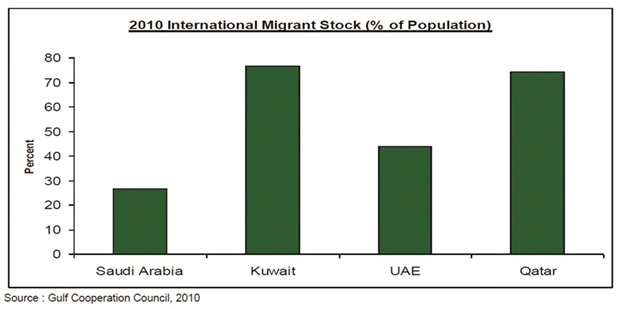Demography will play a crucial role in GCC economies; a report has shown and noted that the region’s growth and future is linked to the dynamics of its population.
The latest Indosuez Wealth Management research report, ‘Macro Comment – Mena Update’, shows countries where demographic growth is strong also have to deal with the problem of dependency ratio. This aspect applies to the GCC countries where dependency ratio is deteriorating due to the high young population and the relative pressure on the productive population.
The issue to be tackled by 2050 will be the explosion in the population aged 65 and over. In Kuwait, the ratio between people aged 65 and over and the 15 to 64 age group was 2.6 in 2015, but will be close to 20 in 35 years’ time.
Dr Paul Wetterwald, chief economist, Indosuez Wealth Management said, “There are some interesting observations for the GCC region when we link demographics with financial markets. Replacing the investment horizon linked to the economic cycle by a longer and more structural timeframe enables us to play other variables – technology, to which productivity is linked, the climate, and demography.
“Interestingly, demography enables us to differentiate regions or countries – locations that benefit from the highest demographic growth are potentially the most advantageous to economic growth. In this context, the US appears to be one of the countries whose decline is furthest away in the future, while Saudi Arabia currently has a high population growth rate of around 1.3% a year.”
The question at the country level is whether immigration will be able to offset the ageing population. Various bodies like the OECD has identified that an increased working population is one of the positive effects of immigration, the report said.
However, using immigration seems easy if one just adds up the figures, but this disregards the creation of social ties that goes hand in hand with the arrival of immigrants. Hence, it seems unrealistic to consider that immigration will occur on a scale such as to stabilise the dependency ratio. Moreover, if such a solution were to occur at the country or regional level, it would obviously not resolve the problems of falling birth rates at the global level.
“In any case, the GCC countries have already used the immigration tool in a major way,” Wetterwald said.
For instance, Saudi Arabia has a population of around 28mn, of which more than 30% are immigrants. With 47% residents below the age of 25 years, the kingdom’s demographics are characterised by a young and fast-growing population.
On one hand, the Saudi population growth was generated by immigration and on the other hand by a fertility rate of 2.1 children per woman. Although the foreign population size is high compared to the OECD countries’ average, other GCC countries are far more dependent on foreign labour than is Saudi Arabia.
While Kuwait and Qatar featured a remarkable 80% of immigrant population in 2010, the proportion of foreigners in the GCC countries reached 42.7% in 2010, compared to 9.7% in 1975.
“One issue is that the oil sector is not labour-intensive, and that many Saudis have no interest in the jobs that most migrant workers occupy,” Wetterwald pointed out.
Having invested in improving the education of its citizens, Saudi Arabia now has to develop the employment opportunities that its graduates crave, and more generally work on reducing the mismatch of skills to job openings that prevail in the kingdom.
Two salient facts hamper Saudi dynamism – women’s low participation in the work force, and an excessive unemployment rate among the young population. Women represent 22% of the labour force and are unemployed nine times more frequently than men. Youth unemployment (15-24 years) stands at 30.4%, five times the 5.6% rate of those aged 25 to 64 years.

.



